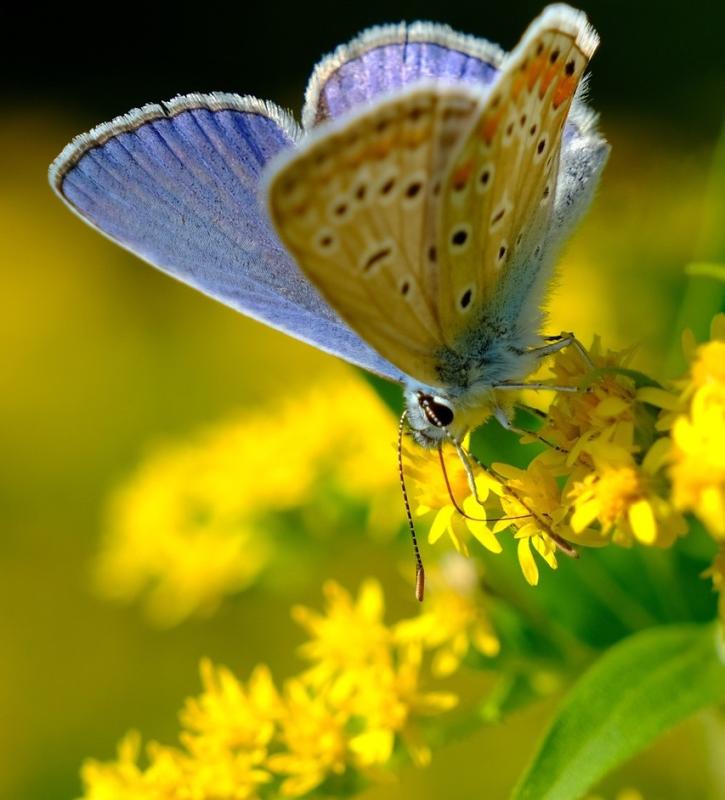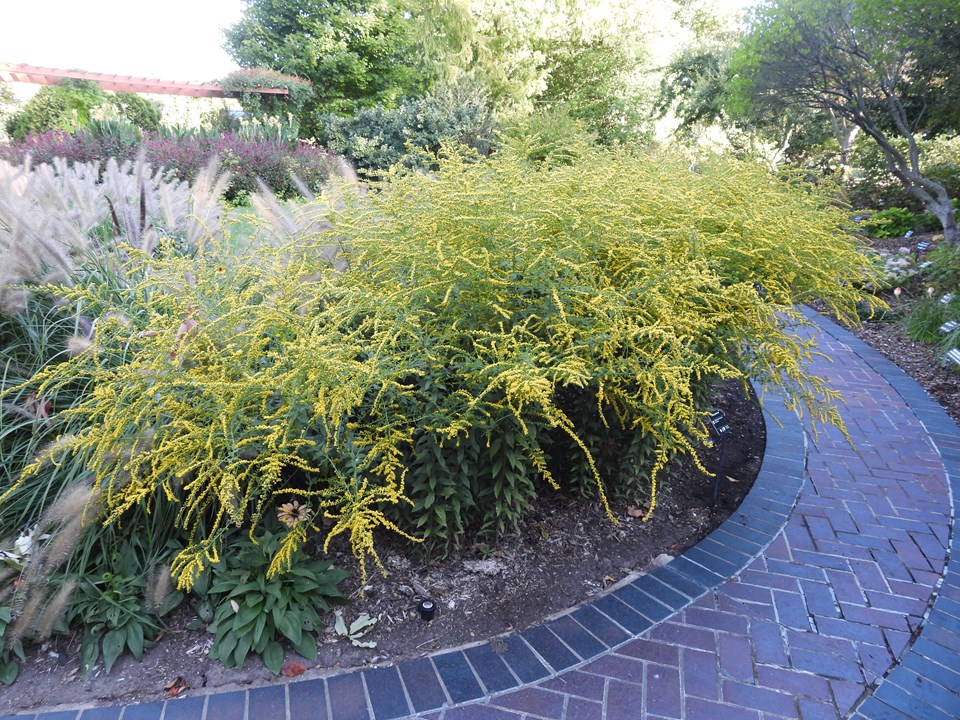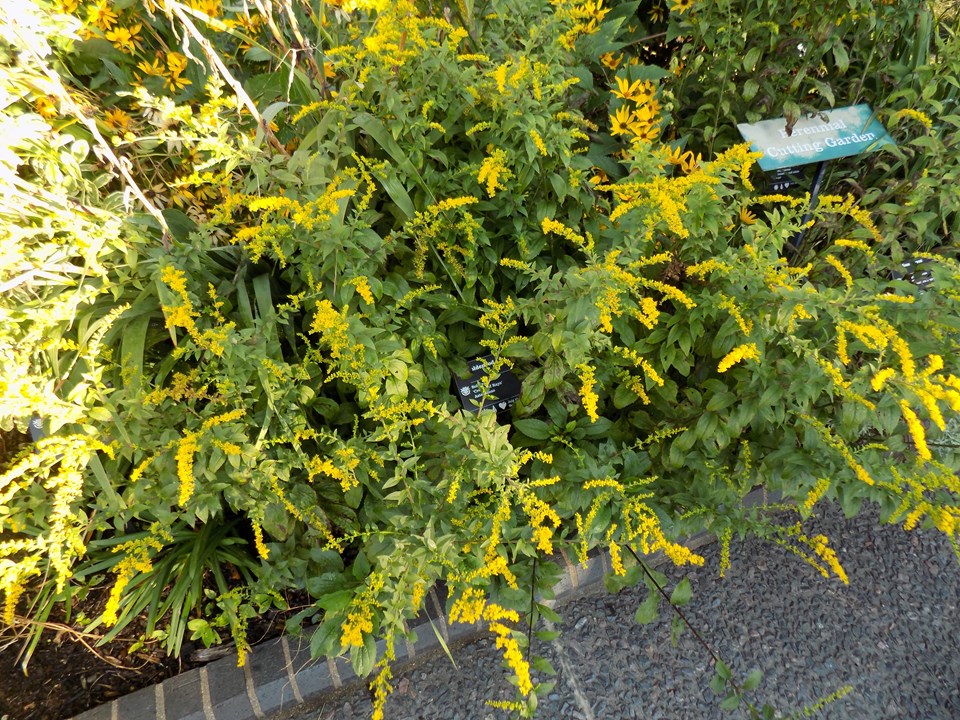08/14/2024
|
Sarah Browning, Extension Educator

Common blue butterfly on goldenrod flowers, Image from Pixabay.com.
Want to brighten up the late summer garden? Then consider a glorious goldenrod!
But wait - worried about late summer allergies? Goldenrod often gets the blame from allergy sufferers, but usually the culprit is ragweed which is wind pollinated and blooms at the same time. Goldenrod pollen is heavy and sticky, requiring insects to move it from flower to flower.
the same time. Goldenrod pollen is heavy and sticky, requiring insects to move it from flower to flower.
 the same time. Goldenrod pollen is heavy and sticky, requiring insects to move it from flower to flower.
the same time. Goldenrod pollen is heavy and sticky, requiring insects to move it from flower to flower.Most goldenrods are clump forming perennials with upright to somewhat arching stems of varying heights. Their flowers are typically yellow, but there are a few scarce white forms. Individual flowers are very small but they are clustered together in great numbers to form flower heads of various shapes and sizes. Plants bloom over a long period in late summer and fall.
Native Species
There are more than 125 species of goldenrods, most of which are native American wildflowers. Many are well adapted to the Midwest. Nebraska has over a dozen native Solidago species that are relatively common, as well as a few rare ones. Common species include showy goldenrod, S. speciosa, which flowers from August through September, and Canada goldenrod, S. canadensis, which flowers from September through October.
There are more than 125 species of goldenrods, most of which are native American wildflowers. Many are well adapted to the Midwest. Nebraska has over a dozen native Solidago species that are relatively common, as well as a few rare ones. Common species include showy goldenrod, S. speciosa, which flowers from August through September, and Canada goldenrod, S. canadensis, which flowers from September through October.
An interesting prairie species, stiff or rigid goldenrod, S. rigida, has flowers in flat-topped clusters atop a rigid stem. Dyersweed or gray goldenrod, S. nemoralis, grows in open woods as well as dry, upland prairies.

Not every goldenrod fits into all landscape situations. Successful use of these herbaceous perennials depends on careful selection. Most of our native species can get tall and rangy in appearance, so are best placed in naturalistic areas of the landscape.
Additionally, goldenrods are great additions to a pollinator garden. Its pollen contains protein, fats and minerals important to bees for winter survival, both honeybees and many of the solitary specialist bees like orchard or mason bees. Flower nectar is an important food source, too. Monarchs rely on goldenrod nectar to fuel their long southward migration.
Butterflies are also attracted to goldenrod, including monarch, clouded sulfur, American small copper, checkerspot, painted lady, common looper, brown-hood owlet and gray hairstreak.
In winter, songbirds feed on goldenrod seeds as a winter food source.
Garden Thug?
Another reason goldenrod gets a bad rap from gardeners is the belief they spread aggressively and will take over the garden. That’s definitely true of some native species, like Canada goldenrod, which can be aggressive spreaders. But newer cultivated varieties are much more well behaved and will stay where you put them.
Great Garden Varieties
However, several goldenrod species and hybrids are outstanding perennial garden plants. They are also excellent cut flowers, both fresh and dried. New cultivars and hybrids offer neat, compact growth, as well as a variety of flower forms.
However, several goldenrod species and hybrids are outstanding perennial garden plants. They are also excellent cut flowers, both fresh and dried. New cultivars and hybrids offer neat, compact growth, as well as a variety of flower forms.
Some of the best cultivars for landscapes include the following:
- Baby Gold - 2 to 2.5 feet tall, produces large flowerheads with bright yellow flowers.
- Cloth of Gold - 18 inches tall, dwarf but vigorous plant, deep yellow flowers blooming in August and September.
- Crown of Rays - 2 to 3 feet tall, strong upright stems form a columnar habit, large flat bright yellow flower heads from mid to late summer.
- Fireworks - 3 feet tall, plume-like flowers explode into branched panicles covered with bright yellow flowers, foliage emerges burgundy in spring and matures to dark green.
- Golden Fleece - 15 to 18 inches tall, forms a dense mat of foliage and flowers which gives it value as a ground cover, golden yellow flowers.
- Goldenmosa - 30 to 36 inches tall, yellow green foliage and yellow flowers, blooms in August.

- Little Lemon - 12 to 18 inches tall, light yellow flowers on short compact plants.
- Wichita Mountain - 2 to 3 feet tall, upright flower stalks resemble gayfeather stems with golden yellow flowers, a very unusual growth habit for goldenrod.
Growing Goldenrod
Goldenrods are easy to grow when planted in good garden soil in full sun. They are extremely hardy, drought tolerant, long-lived perennials. They also have few insect or disease problems and require minimal maintenance.
The hybrid forms will need division every four to five years. Division is best done in early spring just as growth commences, but most goldenrods are also easily propagated by tip cuttings taken in spring or by basal cuttings taken in fall.
Images
- 'Fireworks' goldenrod. Image from Missouri Botanical Garden.
-
'Crown of Rays' goldenrod. Image from Missouri Botanical Garden.
- 'Wichita Mountain' goldenrod. Image from Colorado Spring Utilities, Water Wise Plants.
Search Our Archive
Search or filter the entire Lancaster Extension article database and find the information you're looking for.
Search the Archive
Associated Video
Plants for Hot & Dry Areas
Nebraska Extension Educator Kelly Feehan discusses hot and dry areas of your home landscape and details several ornamental plants that can thrive in those conditions. Feb. 7, 2023